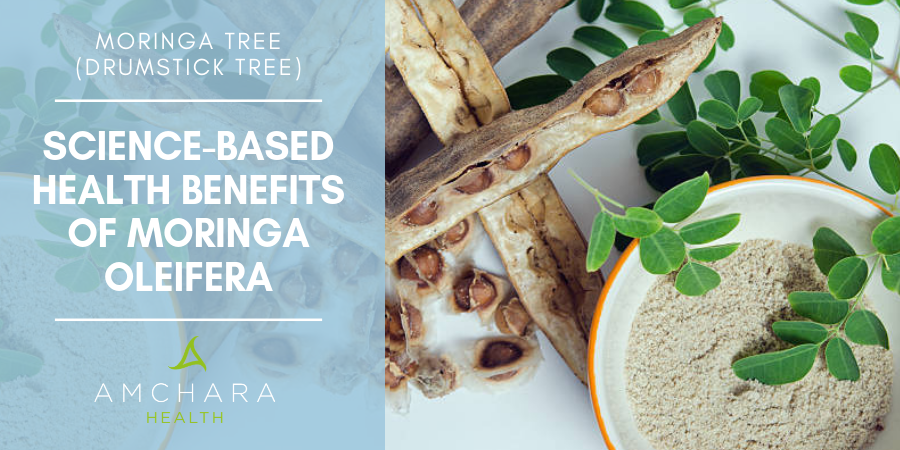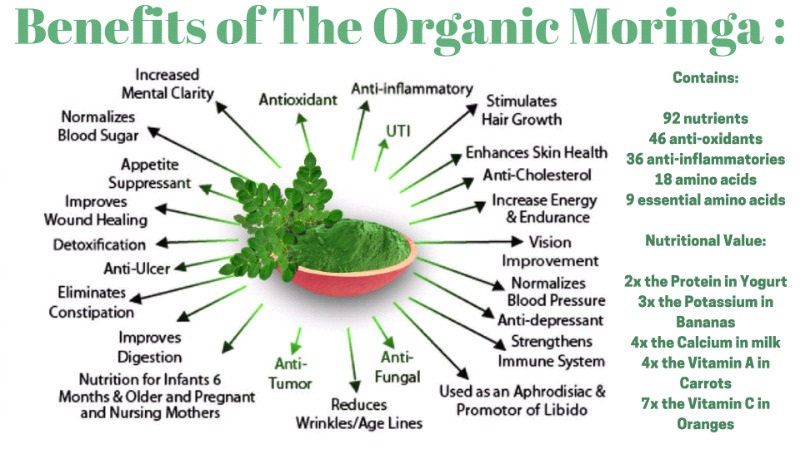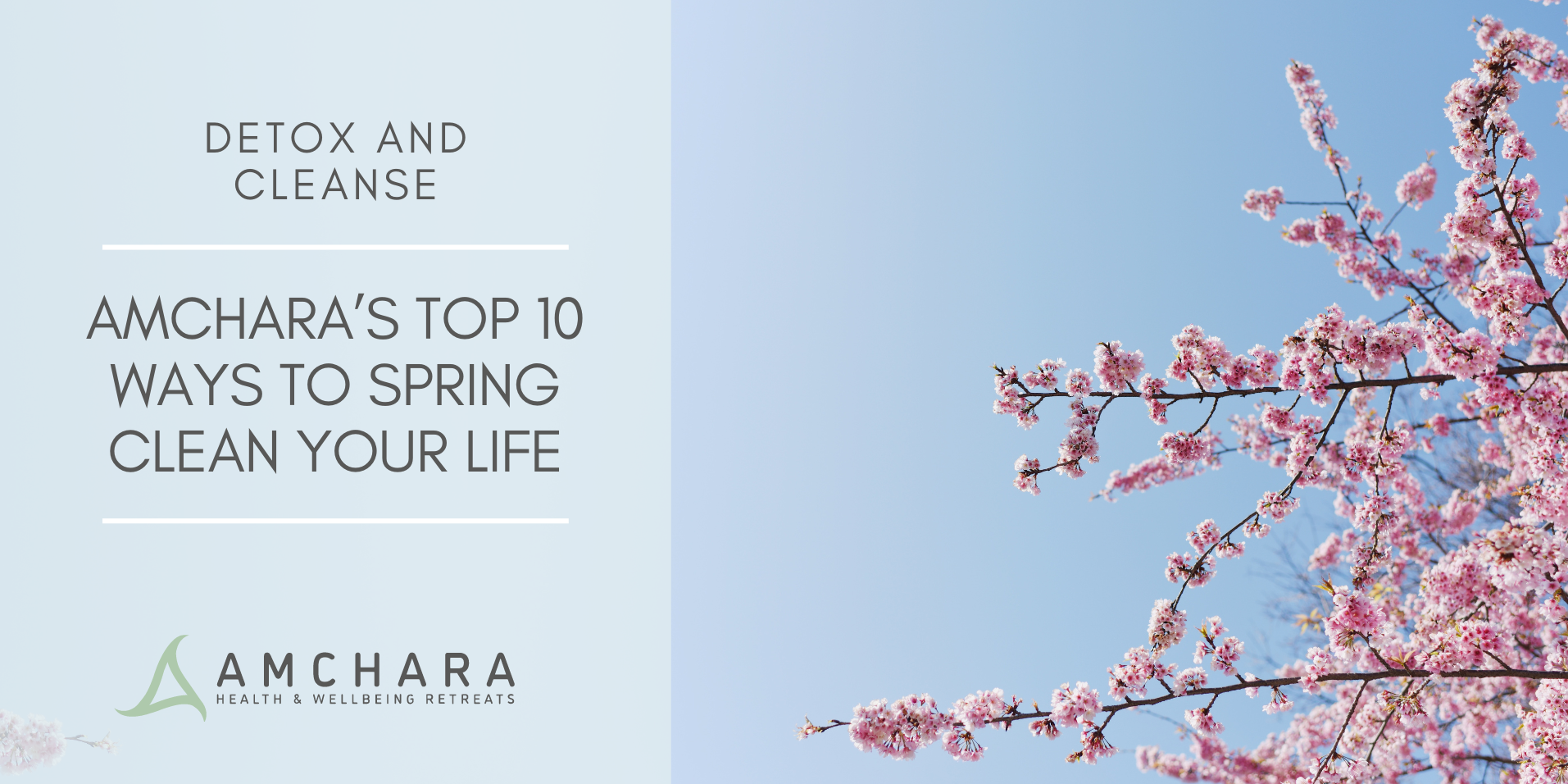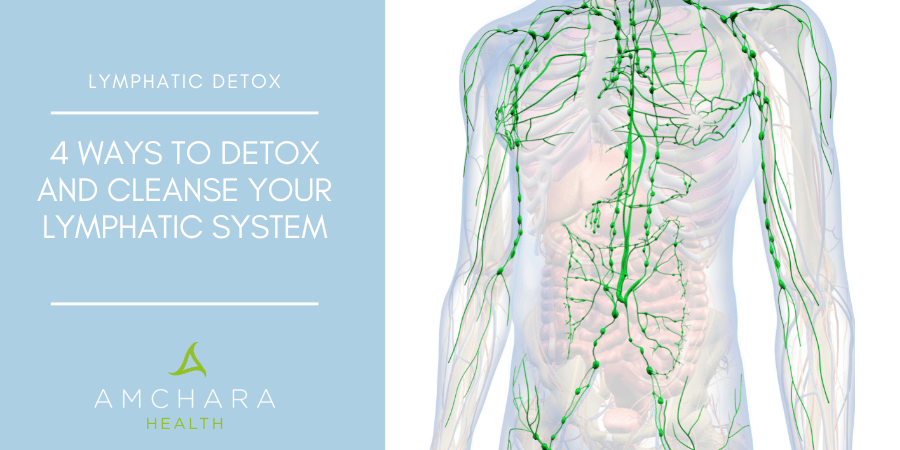If you searched for the list of all the nutrients, antioxidants, vitamins, amino acids and nutrients of the Moringa Tree (drumstick tree) – you’ve found it.
As far as we know this is the only place online where we list all 92 (and more) nutrients of the Moringa tree and we list all the 46 antioxidants of the Moringa tree too.
Deep in the Himalayas is a tree called Moringa oleifera, also known as the drumstick tree, and throughout the subtropics, this tree is cultivated for its amazing health benefits.
This amazing tree has the ability to grow in an array of conditions and its health benefits are astonishing.
The drumstick tree contains a staggering 92 nutrients and 46 natural antioxidants and as it also holds a number of anti-inflammatory compounds.
The sheer number of nutrients found in this tree brings it to the top of the superfoods list and in its native locations it is said to have the ability to help treat more than 300 diseases and illnesses.
To give you an idea, just a single serving of the Moringa tree contains:
-
4 times the amount of calcium in the same amount of milk
-
more vitamin C than 7 oranges
-
double the protein and 3 times the amount of potassium in a banana
Its high antioxidant levels can help fight free radicals, potentially slowing down the ageing process and promoting longevity.
It is thought to be able to help lower cholesterol levels and regulate blood pressure, due to the high levels of niacin and vitamins B3 and B10.
A serving of 100g of this tree gives:
-
over 8g protein
-
over 400mg potassium
-
nearly 450mg calcium
-
164mg vitamin C
-
738 ¼g of vitamin A
Table of Contents:
-
Uses, side effects, interactions and warnings
-
How is Moringa oleifera consumed?
-
Where can you get fresh Moringa in the UK?
Vitamins: Moringa also contains vitamins B1, B2, B3, B6, B7, A, C, K, E and D.
Amino Acids: In addition, it contains various other nutrients, including the following essential amino acids:
Threonine – a nutrient that helps metabolism and prevent fatty build up in the liver. It also aids digestion.
Isoleucine – good for a healthy brain and helps to give the body natural energy.
Leucine – works hand in hand with isoleucine to increase energy levels.
Phenylalanine – aids communication between the brain’s nerve cells and also helps to reduce hunger pangs as well as increasing alertness and improving memory.
Tryptophan – supports your immune system, and its mood boosting ability helps to beat depression and anxiety-associated insomnia. It also reduces the risk of heart attack and lowers bad cholesterol levels.
Lysine – aids the absorption of calcium into the bones, supports antibodies and regulates various hormones as well as inhibiting the growth of virus cells.
Methionine – provides the body with sulphur as well as helping to lower cholesterol. It also supports the liver, kidneys, and helps keep skin, hair and nails healthy.
Valine – helps to keep the mind calm.
There are other amino acids in Moringa too which are not essential to the body but still beneficial in supporting health. These include histidine, alanine, glutamic acid, arginine, cysteine, proline, aspartic acid, glycine, serine and tyrosine. Moringa seeds contain oils that hold high levels of oleic acid, which may act to reduce inflammation.
Nutritional composition and medicinal uses of different parts of Moringa
(source)
|
Part of tree |
Medicinal Uses |
Nutritive properties |
|
Leaves |
Moringa leaves are used to treat asthma, hyperglycemia, Dyslipidemia, flu, heart burn, syphilis, malaria, pneumonia, diarrhoea, headaches, scurvy, skin diseases, bronchitis, eye and ear infections. Also to reduces blood pressure and cholesterol and acts as an antimicrobial, antioxidant, antidiabetic, neuroprotectant and has anti-atherosclerotic agents, . |
Moringa leaves contain fibre, fat proteins and minerals like Ca, Mg, P, K, Cu, Fe, and S. Vitamins like Vitamin-A (Beta-carotene), vitamin B-choline, vitamin B1-thiamine, riboflavin, nicotinic acid and ascorbic acid are present. Various amino acids like Arg, His, Lys, Trp, Phe, Thr, Leu, Met, Ile, Val are present. Phytochemicals like tannins, sterols, saponins, trepenoids, phenolics, alkaloids and flavanoids like quercitin, isoquercitin, kaemfericitin, isothiocyanates and glycoside compounds are present. |
|
Seeds |
Seeds of moringa help in treating hyperthyroidism, Chrohn’s disease, anti-herpes simplex virus, arthritis, rheumatism, gout, cramp, epilepsy and sexually transmitted diseases, can act as antimicrobial and anti-inflammatory agents. |
Contains oleic acid (Ben oil), an antibiotic called pterygospermin and fatty acids like Linoleic acid, linolenic acid, behenic acid. Phytochemicals like tannins, saponin, phenolics, phytate, flavanoids, terpenoids and lectins. Also contains, fats, fibre, proteins, minerals, vitamins A, B, C and amino acids. |
|
Root Bark |
Root bark acts as a cardiac stimulant, anti-ulcer and anti-inflammatory agent. |
Alkaloids like morphine, moriginine, minerals like calcium, magnesium and sodium. |
|
Flower |
Moringa flowers act as hypocholesterolemic, anti-arthritic agents can treat urinary problems and cold. |
Contains calcium, potassium, amino acids and nectar. |
|
Pods |
Moringa pods are used to treat diarrhoea, liver and spleen problems, and joint pain. |
Rich in fibre, lipids, non-structural carbohydrates, protein and ash. Fatty acids like oleic acid, linoleic acid, palmitic acid and linolenic acid are also present. |
Here is the list of the 92 nutrients mentioned:
|
1.iron |
64.Pentena |
|
2.copper |
65.2-Hexenal |
|
3.sodium |
66.Heptenal |
|
4.calcium |
67.2,4-Heptadienal |
|
5.magnesium |
Alcohols |
|
6.phosphorus |
68.2-Pentenol |
|
7.potassium |
69.3,3-Dimethyl-Cyclohexanol |
|
8.sulfur |
70.Benzyl alcohol |
|
9.manganese |
Ketones |
|
10.zinc |
71.Methyl heptenone |
|
11.selenium |
72. 2-Hexen-4-olide |
|
Vitamins |
2-Acetyl pyrrole |
|
12.vitamin B1 (thiamin) |
74.Dihydroactinidolide |
|
13.vitamin E |
Terpenoids |
|
14.Vitamin B1 |
75.alpha-Himachalene |
|
15.Vitamin B6 |
76.(E)-Geranyl acetone |
|
16.Vitamin B7 |
>77.Ti(E)-beta-Ionone |
|
17.Vitamin D |
Acids |
|
18.Vitamin K |
78.Acetic acid |
|
19.vitamin B2 (riboflavin) |
79.Pentanoic acid |
|
20.vitamin B3 (niacin) |
80.Hexanoic acid |
|
21.Vitamin C |
81.Octadecanoic acid |
|
Amino acids |
82.Hexadecanoic acid |
|
22.aspartic acid |
83. erythrobic acid |
|
23.glutamic acid |
84.citric acid |
|
24.serine |
Others |
|
25.glycine |
85.meChlorophyll |
|
26.threonine |
86.meDihydrozeatin |
|
27.alanine |
87.Zeatin |
|
28.valine |
88.Carbohydrates |
|
29.leucine |
89.fibers |
|
30.isoleucine |
Alkaloids |
|
31.histidine |
90.Moringine |
|
32.lysine |
91.Strophantidin |
|
33.arginine |
92.4-(α-l-rhamnosyloxy) |
|
34.phenylalanine |
93.benzyl isothiocyanate |
|
35.tryptophan |
94.4-(4’-O-acetyl-α-l-rhamnosyloxy) |
|
36.cystine |
95.benzyl isothioyanate |
|
37.proline |
Flavonoids |
|
38.tyrosine |
96.Catechin |
|
39.methionine |
97 (β-d-glucopyranosyl-1) |
|
40.cysteine |
98.benzyl thiocarboxamide |
|
41.phenylalanine |
99.Epicatechin |
|
42.choline |
100.4-O-(α-l-rhamnosyloxy) |
|
Fats |
101.benzyl glucosinolate |
|
43.Myristic |
102.Quercetin |
|
44.Palmitic |
103.4-benzylglucosinolate |
|
45.Palmitoleic |
104.Kaempferol |
|
46.Stearic |
105.Niazimicin |
|
47.Oleic |
106.4-(α-l-rhamnosyloxy) |
|
48.Linoleic |
107.benzyl acetonitrile (niazirin) |
|
49.Linolenic |
108.O-ethyl-4-(α-l-rhamnosyloxy) |
|
50.Arachidic |
109.benzyl carmate |
|
51.Eicosenoic |
Phenolic |
|
52.Behenic |
110.Gallic acid |
|
53.Lignoceric |
111.Glycerol-1-1-(9-octadecanoate) |
|
Sterols |
112.p-Coumaric acid |
|
54.Cholesterol |
113.3-O-(6’-O-oleoyl-β-d-glucopyranosyl)-β-sitosterol |
|
55.Brassicasterol |
114.Ferulic acid |
|
56.24-methylenecholesterol |
115.β-sitosterol-3-O-β-d-glucopyranoside |
|
57.Campesterol |
116.Caffeic acid |
|
58.Stigmasterol |
117.3-Hydroxy-4-(α-l-rhamnopyranosyloxy) |
|
59.Ergostadienol |
118.benzyl glucosinolate |
|
60.Clerosterol |
119.Protocatechuic acid |
|
61.Stigmastanol |
120.4-(2/3/4′-O-acetyl-α-l-rhamnopyranosyloxy) |
|
62.β-sitosterol |
121.benzyl glucosinolate |
|
63.venasterol |
122.Cinnamic acid |
|
|
123.Glucosinalbin |
|
|
124.Ellagic acid |
|
|
125.Glucoraphanin |
|
|
126.Glucoiberin |
Here is the list of the 46 natural antioxidants (and more):
Antioxidants (9, 11, 12, 13, 14, 15)
-
β-carotene
-
calcium
-
potassium
-
quercetin
-
chlorogenic acid
-
hydroxyanisole (BHA)
-
butylated hydroxytoluene (BHT)
-
tertiary-butylhydroquinones
-
propyl gallate
-
vitamin E (tocopherols)
-
ascorbic acid (vitamin C)
-
glucose oxidase
-
reduced glutathione
-
citric acid
-
polyphospages
-
aminopolycarboxylic acids
-
vanillin
-
moringine
-
strophantidin
-
4-(α-l-rhamnosyloxy)
-
benzyl isothiocyanate
-
4-(4’-O-acetyl-α-l-rhamnosyloxy)
-
benzyl isothioyanate
-
catechin
-
4-(β-d-glucopyranosyl-1→4-α-l-rhamnopyranosyloxy)
-
benzyl thiocarboxamide
-
epicatechin
-
4-O-(α-l-rhamnosyloxy)
-
benzyl glucosinolate
-
4-(α-l-rhamnopyranosyloxy)-benzylglucosinolate
-
Kaempferol
-
Niazimicin
-
4-(α-l-rhamnosyloxy)
-
benzyl acetonitrile (niazirin)
-
O-ethyl-4-(α-l-rhamnosyloxy)
-
benzyl carmate
-
Gallic acid
-
Glycerol-1-1-(9-octadecanoate)
-
p-Coumaric acid
-
3-O-(6’-O-oleoyl-β-d-glucopyranosyl)-β-sitosterol
-
Ferulic acid
-
β-sitosterol-3-O-β-d-glucopyranoside
-
Caffeic acid
-
3-Hydroxy-4-(α-l-rhamnopyranosyloxy)
-
benzyl glucosinolate
-
Protocatechuic acid
-
4-(2/3/4′-O-acetyl-α-l-rhamnopyranosyloxy)
-
benzyl glucosinolate
-
cinnamic acid
-
glucosinalbin
-
ellagic acid
-
glucoraphanin
-
glucoiber
71 Antimicrobial/biocidal benefits
-
Aspergillus flavin
-
Trichoderma sp
-
Staphylococcus aureus
-
Shigella dysenteriae
-
Shigella boydii
-
Bacillus megaterium
-
Escherichia coli
-
Enterobacter aerogenes
-
Providencia stuartii
-
Klebsiella pneumoniae
-
Pseudomonas aeruginosa
-
Bacillus subtilis
-
Mycobacterium phlei
-
Bacillus cereus
-
Sarcina lutea
-
Basidiobolus ranarum
-
Basidiobolus haptosporus
-
Propionibacterium acnes
-
Staph epidermis
-
Strep pyogenes
-
Trichophyton mentagrophytes
-
Microsporum canis
-
Trichophyton rubrum
-
Epidermophyton floccosum
-
Pseudomonas fluorescens
-
Citrobacter freundii
-
Serratia marcescens
-
Enterobacter sp.
-
Salmonella sp.
-
Proteus vulgaris
-
Streptococcus mutans
-
Vibrio parahaemolyticus
-
Enterococcus faecalis
-
Aeromonas cavieae
-
Streptococcus aureus
-
Streptococcus mutans
-
Penicillium expansum
-
Penicillium digitatum
-
Penicillium aurantiogriseum
-
Penicillium citrinum
-
Aspergillus niger spp.
-
Microcytis aeruginosa
-
Salmonella typhi
-
Vibrio cholera
-
Candida albicans
-
Syphilis
-
Typhoid
-
Urinary Tract Infection
-
Thrush
-
Viral Common cold
-
Epstein-Barr Virus
-
Herpes Simplex Virus (HSV-1)
-
HIV-AIDS
-
HBV
-
Mouth disease virus
-
Foot disease virus
-
Warts
-
Dranunculiasis (guinea-worm)
-
Schistosomes
-
Trypanosomes
-
Bronchitis
-
Earache
-
External Sores/Ulcers
-
Fever
-
Hepatic infections
-
Skin (Dermal) infections
-
Throat Infection
-
Water treatment (general)
-
Asthma
-
Malaria
-
Trypanosoma
Cancer therapy/protection
-
Cancer therapy
-
Anti-tumour
-
Prostate cancer
-
Colon cancer
-
Lung cancer
-
Oesophageal cancer
-
Neuroblastoma
-
Astrocytoma
-
Liver cancer
-
Breast cancer
-
Ovarian cancer
-
Radioprotective
Circulatory/endocrine disorders
-
Anti-anaemic
-
Anti-hypertensive
-
Cardiotonic
-
Diabetes
-
Hypoglycaemia
-
Diuretic
-
Hypocholestemia
-
Hypolipidemic
-
Thyroid
-
Goitre
-
Tonic
-
Hepatorenal
-
Cardioprotective
-
Cardiac arrhythmia
-
Coronary artery disease
-
Cardiac hypertrophy
-
Myocardial infarction
-
Heart failure
Detoxification
-
Antipyretic
-
Purgative
-
Snakebite
-
Scorpion-bite
-
Insect bites
-
Oxidative DNA damage protective
-
Antiperoxidative
-
Tsetse fly bites
Digestive disorders
-
Colitis
-
Diarrhoea
-
Digestive
-
Dysentery
-
Flatulence
-
Stomach ulcers
-
Intestinal ulcers
-
Gastritis
-
Intestinal spasms
-
Swelling
-
Liver fibrosis
-
Fatty liver
-
Aiding digestion
Inflammation
-
Rheumatism
-
Joint pain
-
Oedema
-
Arthritis
-
Abscesses
Immunity
-
Immune stimulant
-
Weak immunity
-
Lupus
Nervous disorders
-
Anti-spasmodic
-
Epilepsy
-
Hysteria
-
Headache
-
Paralysis
-
Convulsions
-
Reduce pain
Moringa oleifera & nutrition
-
Anti-nutritional factors
-
Antioxidant
-
Carotenoids
-
Energy
-
Goitrogen
-
Iron deficiency
-
Oil quality
-
Protein
-
Vitamin/mineral deficiency
-
Malnutrition
Reproductive health & Moringa oleifera
-
Abortifacient
-
Aphrodisiac
-
Birth Control
-
Lactation enhancer
-
Prostate function
-
Increase sex drive
-
Improves the quality and flow of mothers’ milk
-
Sexually transmitted diseases
-
Help during labour
Skin disorders & Moringa oleifera
-
Antiseptic
-
Astringent
-
Pyodermia
-
Rubefacient
-
Vesicant
-
Boils
-
Fire burn wounds
-
Skin rashes
Others
-
Bladder
-
Urination problems
-
Catarrh
-
Gout
-
Hepatamegaly
-
Lactation
-
Low back pain
-
Kidney pain
-
Kidney stones
-
Scurvy
-
Splenomegaly
-
Athlete’s foot
-
Dandruff
-
Warts
-
Weakness of thigh
-
Weakness of calf muscles
-
Wounds
-
Obesity
-
Muscle diseases
-
Hysteria
-
Colds
-
Coughs
-
Eye infections
-
Throat infections
-
Dental decay
-
Aphrodisiac
-
Dental caries/toothache
Sources:



.jpg)



